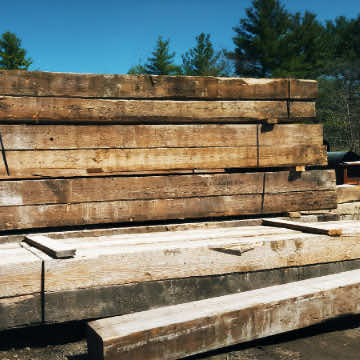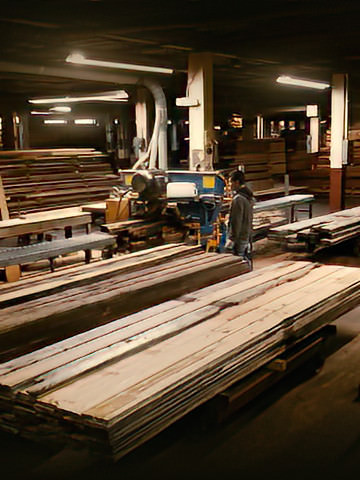Reclaimed Heart Pine vs. Yellow Pine

The beauty of both reclaimed heart pine and sustainable yellow pine make both woods popular choices for flooring. But what’s the difference between these two woods and what are the relative advantages of either one when it comes to your renovation or new build project?
Into the Woods: Reclaimed Heart Pine vs. Yellow Pine
The woods commonly known as heart pine and yellow pine are from similar trees with very different histories.
Heart Pine
Heart pine refers to mature longleaf pine harvested from trees up to 400 years old. These trees grew widely across the south-eastern States and were valued for the hardness and beauty of their heartwood.
Heart pine was widely used for flooring in homes and factory buildings along the East Coast, especially after the Civil War. By 1920 almost all of the original old-growth forests had been harvested, with exploitation hastened by the development of circular saws that could be powered by water or steam.
Heart pine takes many decades to mature, and today the major source for true mature heart pine is from lumber and flooring recovered from older buildings.
Yellow Pine
Yellow pine usually refers to less mature wood from second-growth replanted forests of southern short-leaf or loblolly pine. These trees take 30-40 years to grow to a harvestable size. The golden wood is softer than heart pine and lacks the distinctive reddish interior grain.
Southern yellow pine has been widely used for lumber and flooring since World War II, although it should not be confused with the western Ponderosa pine or white pine varieties. Its rapid growth and suitability for use in commercial plantations mean it’s a popular and renewable source of timber for construction and flooring, although quality does vary.
Different Strokes: Reclaimed Heart Pine vs. Yellow Pine
Both reclaimed heart pine and yellow pine offer appealing qualities for use in flooring. Each however has unique qualities that are better suited for particular contexts.
Appearance
Good quality heart pine offers a mix of golden sapwood and darker heartwood. Most heart pine today is reclaimed wood, meaning it has been recovered from older buildings when they are renovated or demolished.
Genuine reclaimed heart pine comes with a particular history that adds to its beauty, including nail holes, oxidation, or even the distinctive swirls left by early circular saws.
Yellow pine, however, is usually all sapwood, and its color brings a warm glow to every room it’s used in. Since these trees are usually younger and smaller than the original longleaf pines, they generally have fewer knots than heartwood and their growth lines aren’t as dense.
Durability
Reclaimed heart pine is significantly harder than yellow pine because of its tighter grain and greater age. Heart pine measures around 1225 on the Janka scale for assessing the hardness of wood, compared with around 870 for yellow pine.
Hardness and durability are why heart pine has been the go-to choice for centuries for everything from shipbuilding to construction, and why heart pine lasts so well, even after decades of punishment.

The softer sapwood of yellow pine will not wear quite as well as heart pine, but well-aged and seasoned wood will last for decades if well cared for. Its softness also gives yellow pine more flexibility, making it a popular and affordable choice for flooring.
Sourcing and Availability
Heart pine is available mainly as reclaimed wood, therefore its supply is finite. While wood reclaimers like E.T. Moore are always working to recover additional supplies of heart pine, there is simply less of this wood to go around, especially in longer lengths of wider grades.
Yellow pine is commercially grown and widely available in a range of lengths and grades. However, quality can vary so again, it pays to work with reputable reclaimers who can access stores of older, better seasoned yellow pine that will age with your building.
Cost
Reclaimed heart pine is never cheap, although some varieties, such as those with historic nail holes or darker knots are more affordable. Prices for heartwood generally run from two to four times that of a similar grade of quality yellow pine, if available. And, if you insist on custom milling boards of heartwood to your specifications, the cost can be many times higher.
Yellow pine is an affordable choice that outperforms many cheaper woods. Maintain it well and it will serve you for many years while acquiring a luster and character all of its own.
Matching
If you are renovating or adding to a house dating from the 1940s onwards, it is likely any pine flooring is yellow pine (although possibly also white pine or fir). E.T. Moore will be able to match this well with a suitable grade and color of new growth yellow pine.
If your project dates from the 1920s or older, we will match this with a suitable grade of heart pine. It’s not possible to match a yellow pine with a heart pine in any grade.
E.T. Moore: Your Source for Quality Heart Pine vs. Yellow Pine

At E.T. Moore, we offer an unrivaled ability to match both reclaimed and new growth pine with quality stock—it's why we’re called in to source flooring for historical restoration projects. The difference lies in our experience in sourcing hard-to-find woods and the depth of our huge on-site inventory of carefully stored reclaimed wood.
We can match several varieties of quality reclaimed heart pine in different grades for your special construction or restoration. We also supply sustainably grown and harvested yellow pine and custom milling to provide a premium option for new build projects.
Click below to learn more.
Reclaimed Wood Flooring